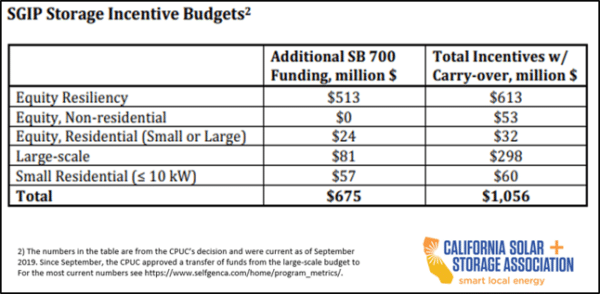Corrections made 11/27
***
California’s Self-Generation Incentive Program has a history of costly, unintended consequences that reveal flaws in the program and in human behavior.
Here’s another big incentive program problem:
“Much” of the $612 million “equity” and “equity resiliency” incentive for low-income, vulnerable customers and critical facilities in high-risk fire threat areas or those affected by public safety power shutoffs has been used up by customers using electricity for well pumps at second-homes, according to reporting in RTO Insider.
CALSSA asserts that we don’t have an accurate number on the figure of second homes or income levels.
As pv magazine has reported, the Equity Resiliency incentive level is set at $1,000/kWh, which is enough to almost completely cover the installation of a storage system. The Equity Budget incentive was raised to $850/kWh and is directed at low-income customers in disadvantaged communities, and institutions, agencies and small businesses in disadvantaged communities.
But instead, “We were seeing some second-home residents receive the hefty grants, which pay the full cost of battery storage and solar cells to charge the units,” said CPUC Commissioner Clifford Rechtschaffen, quoted in the same RTO article.
Note: Rechtschaffen is not correct — solar cells are not included in this program.
“More than eight months after the decision took effect, the state’s three large investor-owned utilities haven’t started reaching out to medically vulnerable customers,” Rechtschaffen said. “Instead, developers of storage systems have targeted households with wells, regardless of income, and scooped up much of the funding that was supposed to last through 2024.”
The SGIP
The SGIP is a long-time, generous subsidy established by California’s PUC to support distributed energy resources, contribute to GHG emission reductions, demand reductions, and reduced customer electricity purchases. It provides one-time, upfront rebates for distributed energy systems on the customer’s side of the utility meter.
The lucrative program has gone through enormous changes since its creation as a peak-load reduction program after the California energy crisis in 2001. The old program was heavy on generation and had an inordinate fondness for fuel cells.
The 2020 SGIP is a different animal — it’s a stark response to California’s wildfires and Public Safety Power Shutoffs (PSPS) with 80% of its SB 700 funds devoted to energy storage, along with a marked emphasis on providing resiliency for vulnerable Californians in vulnerable locations.
The 2020 SGIP guide from the California PUC is here. The breakdown from Energy Toolbase is here. Here’s the breakdown of the incentive’s budget.

Previous glitches in the program
In addition to to the second-home, well-pump imbroglio, previous incarnations of the SGIP have seen vendors game the system’s bidding process.
In 2016, a single company, Stem, was able to secure the first 56 applications in a solicitation. Stem was able to monopolize the online submission process for the first 2 or 3 minutes of the live opening. Stem and another company were looking to gain a cyber-advantage in the CPUC’s impractical first-come-first-served submission process.
Other glitches have allowed one or two vendors or technologies to dominate the program.
Some technologies, such as fuel cells, won an inordinate share of the incentive in previous years. Bloom Energy’s natural-gas-powered fuel cells received hundreds of millions in funding that was meant to reduce GHG emissions. Tesla Energy has been a loyal beneficiary of the incentive program.
Utility customers pay for the program through a charge on their electric bills. PG&E’s residential customers pay about $5.00 per year, industrial customers pay an average of $3600 per year, according to the CPUC. The fees generate more than $80 million per year.
A recent report cited measures meant to prevent abuse of the program.
- Project cost cap: the sum of incentives for a project (SGIP plus ITC), cannot exceed the total installed storage project cost.
- The total SGIP incentive per project is limited to $5 million.
- Developer cap: a single developer is limited to 20% of the incentive for a specific budget category in each incentive step.
The CPUC is gathering information and will be making a decision on possible retroactive actions on the equity subsidy this week.
***
The original post asserted that there was $600 million misuse of ratepayer funds. This is incorrect. The actual portion used by second homes or customers over the income limit has not been furnished by the CPUC and is not known.
This content is protected by copyright and may not be reused. If you want to cooperate with us and would like to reuse some of our content, please contact: editors@pv-magazine.com.








Back up grants, to California Residents, should NOT be based on income but in ownership of the property in question, the need for backup power durring utility shut offs and getting people off the grid during “Flex Alerts” and Well pumps, second/retirement homes in “at risk” areas should all be eligable. The Taxpayers and ratepayers, who pay the taxes and the high California utility rates, should also be given the chance to get the grant, money they PAID in all these years, for their at risk homes and property. The grants only pay for the instalation and not the batteries or the solar panels that they must buy out of their own money then wait for the 26% Tax Credit from the Federal government for their primary residence or get nothing for their second home that may be their future retiement home when they sell their primary residance flat or home in the city. Any home, shifting off the grid, from fossile fuels to solar is a good thing. Calling using the money to install storage systems a misuse based only on income and not on real needs is totaly bogus and an attempt to shut down future grants for renewable energy enhancements in California by the fossil fuel right wing pundents and taxpayers that have no interst in curbing global climate change.
Quote: “These measures were unable to prevent the current $600 million misuse of ratepayer funds. “The CPUC is gathering information and will be making a decision on possible retroactive actions on the equity subsidy this week.” Since when can poor people even consider buying solar when they do not own the appartment, small homes or travel trailers they rent? If you are a ratepayer, you should be entiled to some of the funds if you put in a system and cover all the rest of the system’s costs.
As far as the wells go, “Water” is very importants to the financial strength of California and when the grid is down, crops die, cattle and livestock go thirsty as well as workers who depend on the water for sanitation working in our fields. We already have programs, in the inner cities, for the poor for electrical power discounts.
Medical back up needs can be supplied by UPS units that have back up batteries included and come with many of the devices used built in. Those UPS units, if not supplied under Medicare or Medical, should be under a different program because they are stand alone, single device, grid power charged units. Saying a person with an oxygen genrator needs a 4,000 watt solar powered system for a 50 watt device and a 14,000 watt hour battery storage (Powerwall) when a couple of 1,200 watt hour battery would last 24 hours each is realy over kill and using this argument to limit funds to others, who need water from wells or lighting and power for children to study from home on electronic dvices, is also bogus.
The fact that the companies, that sell the equipment, are getting buyers pecause they can get the word out better than the State does and have a sales incentives to get the funds first is just good business for them and their California rate paying customers. The customer must still qualify in the end or some else will get the funds. This just sounds like someone is looking at an excuse to end the programs that is helping thousands of ratepayers get off the grid and have battery back up when needed.
Nothing surprising here…. if you do a similar “Research” on Trillions of Dollars doled out to the Polluting Fossil and Nuclear Industry since World War II…. you will be shocked at the legalized “Uncle Sam ‘s Sponsored Rip Off”….
This Billion Dollar “Scam”… if that is what it is…. is just a peanut or so compared to the Fossil and Nuclear Industry wallowing in “Research and Exploration” Funds…. but hey… this is exactly how Capitalism works… nothing new here…